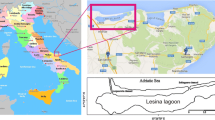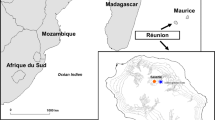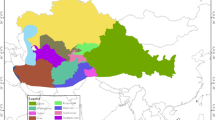Abstract
Foxtail millet, Setaria italica is still cultivated in Mazandaran (N-Iran). It is used for the preparation of local food and for feeding cage-birds. The cultivated race is convar. moharia, formerly widely grown from Europe to SW Asia. The newly found material allows conclusion with respect to evolution and distribution of this old crop.
Similar content being viewed by others
Avoid common mistakes on your manuscript.
Setaria italica was included in the original treatment of Flora Iranica (Bor 1970) citing a few localities. In his additions, Scholz (1981) refers to this species, based on a herbarium specimen of Gauba: “In valle fluvii Calus, 500 m, 8.10.1937, Cult.”.
Material from this area was, again, collected in 2004 (Khoshbakht 2005). Foxtail millet, formerly a famous crop of Persia (Körnicke 1885), and for a long time a traditional cereal in Mazandaran, has become a very rare and underutilized crop as defined by Hammer et al. (2001).
The species, locally named “Gavras italiaei; Gours” was formerly used in a wide range of local cuisines. The grains were boiled like rice, cooked into porridge, or after grinding baked into flat bread. Today we found a few accessions mostly grown for cage-birds and poultry.
A determination of the material on the basis of herbarium specimens and a cultivation experiment in the greenhouse of University of Kassel in Witzenhausen, Germany, (Fig. 1) came to the result that the material belongs to the following race (in agreement with Scholz 1981):
Setaria italica (L.) P. Beauv. convar. moharia (Alef.) Koern. in Handb. Getreideb. 1, 1885, 272 (sub Panicum italicum) ex Mansf. in Züchter 22 (1952) 311. – Panicum italicum L. var. moharia Alef., Landw. Flora 1866, 315; Setaria italica ssp. colchica Maisaya et Gorgidze in Soobšč. A. N. Gruz. SSR 119, 1985, 589, nom. inval.
Short description (see also Mansfeld 1952; Clayton 1980): Annual; stems upright, (25–) 50–140 cm, up to 1 cm thick, unbranched or branched in the lower part. Leaves 20–40 cm × 6–30 mm; ligula ending in a row of hairs. Panicle 4–30 cm long, 1.5–3 mm thick, ellipsoid to cylindrical, the rachis villous; bristles 2–16 mm, 2–5 per cluster of spikelets, antrorsely scabridulous, yellowish to black, mostly longer than the spikelet; upper glume 2/3 as long to almost as long as the spikelet. Spikelet 2–3 mm, green, mature yellow, red or brown. Upper lemma smooth, disarticulating from the rest of the spikelet at maturity. Stigma yellowish. Spikelets not disarticulating at maturity, only the grain, enclosed by the glumae, becomes free.
Convar. moharia is the more primitive race, with a tendency towards cross pollination (Körnicke 1885), closely related to the wild progenitor S. viridis (L.) P. Beauv.
It can be differentiated from convar. italica by looser panicles, shorter panicle branches and smaller grains. The flower glumes are smooth and shining, easily disarticulating together with the mature caryopsis from the persisting lower glumes (see also Tzvelev 1976; Scholz 1981). This race is mostly 50–100 cm tall, with 5–52 (ave. 9) culms per plant. They have small (5–20 cm long), erect or slightly nodding panicles with short (1–3 cm long) fascicle branches on which the spikelets are arranged in clusters (Prasada Rao et al. 1987; de Wet et al. 1979). The setae are well developed. Differing from weedy variants by having spikelets that persist after maturity, aiding harvest.
This is one of the two major entities of S. italica (convar. italica and convar. moharia (Alef.) Koern. ex Mansf.) “races” according to Prasada Rao et al. (1987). Convar. moharia predominated the traditional agriculture from Europe. It was found, e.g. in the last fields of slash-and-burn cultivation in Slovakia (Kühn and Hammer 1979). Its distribution in the eastern part of the area of the species remained unclear. Körnicke (1885) provided a very detailed description and found the most eastern proveniences from Hungary (p. 276). This was confirmed also by Metzger (1841). Generally SW Asia was considered as the area of distribution of this race (Prasada Rao et al. 1987). As the growing area of convar. moharia is still declining, it was possibly one of the last opportunities for indicating the former large distribution area of this race.
Because of its typical geographical definition, Scholz (1981) considered this race as a subspeciesFootnote 1.
The hypothesis of a multiple origin of foxtail millet is supported by archeological, morphological, and molecular evidence (Pernès 1985; Sakamoto 1987, Li et al. 1995; Fukunaga et al. 2002; Darmency 2005).
Two main centers of origin are considered––China, where it has been domesticated already about 8,000 years ago (Li and Wu 1996) and where is still an important center of variation (Kawase and Sakamoto 1984; Jusuf and Pernès 1985, Baik et al. 1986; Nguen and Pernès 1985; Gao and Chen 1988; Li et al. 1995; Li et al. 1996) and––SW Asian center (Vavilov 1926, 2nd millennium BC in central Europe, late Bronze Age-Greece, Zohary and Hopf 1988)—along the Alps it was cultivated since 5,000 years (Hammer et al. 1999).
The wild progenitor Setaria viridis (L.) P. Beauv. has a very wide distribution including large parts of Eurasia and North Africa. Setaria viridis var. major (Gaud.) Posp. is usually seen as an introgression product of the wild Setaria viridis with cultivated races, it is characterized by larger panicles than the wild species and belongs to the weedy races.
Formerly the hypothesis was proposed that there is an evolutionary continuum starting with Setaria viridis (L.) P. Beauv. – S. viridis var. major (Gaud.) Prosp., S. viridis ssp. pycnocomum (Steud.) Tzvel. – S. italica (L.) P. Beauv. convar. moharia (Alef.) Mansf. – S. italica var. media (Koern.) Scheibe – S. italica convar. italica (convar. maxima (Alef.) Koern. ex Mansf.) (see Werth 1937 emend. Scheibe 1943; Williams and Schreiber 1976).
Now a more dynamic model has been proposed (Table 1). The newly collected material allows the following conclusions and discussions:
(1) Distribution of Setaria italica convar. moharia.
Iran is an important area for the production of foxtail millet since classical times (see Körnicke 1885). Now the area of distribution of this race includes northern Iran indicating possible connections to the East via Afghanistan (Vavilov and Bukinich 1929) where the race was exclusively found, and the Hindukush, which has been characterized as a refuge area (Scheibe 1943). To the west there is an interruption in the distribution in the neighbouring Caucasus where only convar. italica is cultivated (Dekaprelevich and Kasparian 1928; Maissurian 1929), i.e. eastern domesticate!?
Further to the west the convar. moharia can be, again, found. An important area of cultivation has been Hungary. Germany belongs to the traditional growing areas of Setaria germanica (Mill.) P. Beauv. (see Hoops 1905). As convar. moharia cultivation continues to decrease, it becomes more and more difficult to define the traditional growing area.
(2) As the wild progenitor unanimously S. viridis is discussed. This species is also occasionally cultivated (Fritsch 2001), mainly as a fodder crop, but also for the grains as observed by Scheibe (1943) in Hindukush. This cultivated race of S. viridis, grown in the Parun-valley of Hindukush, had a thousand-grain-weight of 0.24 g. As compared to convar. indica (2.78–3.26 g) and convar. italica (3–4 g) (Scheibe 1943).
The hypothesis that S. viridis ssp. pachystachys (Franch. et Savat.) Masam. et Jang. with its main distribution in China or Japan gave rise to convar. italica and ssp. viridis with a very large but generally more western distribution is the progenitor of convar. moharia is still under discussion.
Setaria viridis and S. italica easily introgress (see Table 1). But usually the introgression products are derived from crosses of convar. italica and S. viridis (as in the cases of S. ketzchovelii Menabde et Eritsian and S. gigantea (Franch. et Savat.) Makino, see also Takahashi and Hoshino 1934; Harlan 1965; Tzvelev 1976).
One of the reasons may be that S. viridis and S. italica convar. moharia are rather similar and introgression products between them are difficult to recognize. Introgressions between convar. italica and convar. moharia have been postulated based on observations in Hindukush (Scheibe 1943). They resulted in a stable new race with character states in between both parents (S. italica ssp. media (Koern.) Scheibe).
(3) A refugial area for Setaria italica was found in the valley of Hindukush (Scheibe 1943). This area has been also rich in diversity of foxtail millet. Today such diversity centers also in the mountains are vanishing because of the decline of traditional agriculture in many parts of the world. They are becoming poor refugial areas as in the case of S. italica convar. moharia in the Albourz mountains of Iran. Increasing efforts are necessary for the collection of such rare races not only as a genetic resource but also as possible missing link for constructing of evolutionary pathways in crop plants. Still most data in literature focus on S. italica convar. italica whereas the forage grass convar. moharia, though it was and sometimes still is cultivated as a grain crop, received only limited attention (see Darmency and Pernès 1987; Till-Bottrand et al. 1992; Darmency 2005).
Notes
Setaria italica subsp. moharia (Alef.) Scholz in Willdenowia 36 (2006) 663
References
Alefeld F (1866) Landwirtschaftliche Flora oder die nutzbaren kultivierten Garten- und Feldgewächse Mitteleuropas. Berlin
Baik M.-C, Hoang H.-Dz, Hammer K (1986) A check-list of Korean cultivated plants. Kulturpflanze 34:69–144
Bor NL (1970) Gramineae. In: Rechinger KH (ed) Flora Iranica. 70:203–211. Graz, Austria: Akademische Druck- u. Verlagsanstalt
Clayton WD (1980) Setaria P. Beauv. In: Flora Europaea 5:263–264
Darmency H, Pernès J (1987) An inheritance study of domestication in foxtail millet using interspecific crosses. Plant Breed 99:30–33
Darmency H (2005) Incestuous relations of foxtail millet (Setaria italica) with its parents and cousins. In: Gressel J (ed) Crop ferality and volunteerism. CRC Press, Boca Raton, pp 81–96
Dekaprelevich LL, Kasparian AS (1928) A contribution to the study of foxtail millet (Setaria italica P.B. maxima Alef.) cultivated in Georgia (western Transcaucasia). Bull Appl Bot Plant Breed 19:533–572
De Wet JMJ, Oestry-Stidd LL, Cubero JI (1979) Origins and evolution of foxtail millets. J Agric Trop Bot Appl 26:54–64
Fritsch R (2001) Panicoideae. In: Hanelt P. and Institute of Plant Genetics and Crop Plant Research (eds) Mansfeld’s encyclopedia of agricultural and horticultural crops, vol 5. pp 2627–2750
Fukunaga K, Wang Z, Kato K, Kawase M (2002) Geographical variation of nuclear genome RFLPs and genetic differentiation in foxtail millet, Setaria italica (L.) P. Beauv. Genet Resour Crop Evol 49:95–101
Gao MJ, Chen JJ (1988) Isozymic studies on the origin of cultivated foxtail millet. Acta Agron Sinica 14:131–136 (in Chinese)
Hammer K, Knüpffer H, Laghetti G, Perrino P (1999) Seeds from the past. A catalogue of crop germplasm in the Central and North Italy. IdG, Bari
Hammer K, Heller J, Engels J (2001) Monographs on underutilized and neglected crops. Genet Resour Crop Evol 48:3–5
Harlan JR (1965) The possible role of weed races in the evolution of cultivated plants. Euphytica 14:173–176
Hoops J (1905) Waldbäume und Kulturpflanzen im germanischen Altertum. Straßburg
Jusuf M, Pernès J (1985) Genetic variability of foxtail millet (Setaria italica P. Beauv.). Theor Appl Genet 71:385–391
Kawase M, Sakamoto S (1984) Variation, geographical distribution and genetic analysis of esterase isozymes in foxtail millet, Setaria italica (L.) P. Beauv. Theor Appl Genet 67:529–533
Khoshbakht K (2005) Agrobiodiversity of plant genetic resources in Savadkouh/Iran with emphasis on plant uses and socioeconomic aspects. Ph.D. Thesis, Faculty of Organic Agricultural Sciences, University of Kassel, Witzenhausen, Germany
Körnicke F (1885) Die Arten und Varietäten des Getreides. Handbuch des Getreidebaus, Bd. 1
Kühn F, Hammer K (1979) Das Ausklingen der Brandrodungskultur in Zentraleuropa. Kulturpflanze 27:165–173
Li J, Wu SZ, Cao JS (1995) Cluster analysis of an international collection of foxtail millet (Setaria italica (L.) P. Beauv.). Euphytica 83:79–85
Li J, Wu SZ (1996) Traditional maintenance and multiplication of foxtail millet (Setaria italica (L.) P. Beauv.) in China. Euphytica 87:33–38
Li J, Wu SZ, Cao JS, Zhang X (1996) A phenotypic diversity analysis of foxtail millet (Setaria italica (L.) P. Beauv.) landraces of Chinese origin. Genet Resour Crop Evol 43:377–384
Li J, Jia J, Wang J, Wu SZ (1998) Intraspecific and interspecific variation in Setaria revealed by RAPD analysis. Genet Resour Crop Evol 45:279–285
Maissurian NA (1929) The millet of Georgia. Bull Appl Bot Plant Breed 22:147–184
Mansfeld R (1952) Zur Systematik und Nomenklatur der Hirsen. Züchter 22:304–315
Metzger J (1841) Landwirtschaftliche Pflanzenkunde. Heidelberg
Nguyen van E, Pernès J (1985) Genetic diversity of foxtail millet (Setaria italica). In: Jacquard P et al. (eds) Genetic differentiation and dispersal in plants, Springer, Berlin, Heidelberg, pp 113–128
Pernès J (1985) Evolution des plants cultivées: ľ example des céréals. La vie Sci 5:429–447
Prasada Rao KE, de Wet JMJ, Brink DE, Mengesha MH (1987) Intraspecific variation and systematics of cultivated Setaria italica, foxtail millet (Poaceae). Econ Bot 41:108–116
Sakamoto S (1987) Origin and dispersal of common millet and foxtail millet. JARQ 21:84–89
Scheibe A (1943) Die Hirsen im Hindukush. Eine Beitrag zur Kenntnis von Kulturpflanzen in geographischer Rückzugsposition. Z Pflanzenzüchtg 25:392–436
Scholz H (1981) Ergänzungen und Verbesserungen zur “Flora iranica”: Gramineae. Willdenowia 11:259–266
Takahashi N, Hoshino T (1934) Natural crossing in Setaria italica (Beauv.). Proc Crop Sci Soc Japan 6:3–19
Till-Bottrand I, Reboud X, Braband P, Lefranc M, Kherissi B, Vedel F, Darmency H (1992) Outcrossing and hybridization in wild and cultivated foxtail millets; consequences for the release of transgenic crops. Theor Appl Genet 83:940–946
Tzvelev NV (1976) Zlaki SSSR. (Poaceae URSS). Nauka, Leningrad
Vavilov NI (1926) Studies of the origin of cultivated plants. Inst Appl Bot Plant Breed Leningrad
Vavilov NI, Bukinich DD (1929) Agricultural Afghanistan (Russ., Engl. summary) Leningrad
Werth E (1937) Zur Geographie und Geschichte der Hirsen. (Zur Geographie und Geschichte der Kulturpflanzen und Haustiere. XIII). Angew Bot 19:42–88
Williams RD, Schreiber MM (1976) Numerical and chemotaxonomy of the green foxtail complex. Weed Sci 24:331–335
Zohary D, Hopf M (1988) Domestication of plants in the Old world. Oxford University Press, Oxford
Author information
Authors and Affiliations
Corresponding author
Rights and permissions
About this article
Cite this article
Hammer, K., Khoshbakht, K. Foxtail millet (Setaria italica (L.) P. Beauv.) in Mazandaran/Northern Iran. Genet Resour Crop Evol 54, 907–911 (2007). https://doi.org/10.1007/s10722-007-9211-z
Received:
Accepted:
Published:
Issue Date:
DOI: https://doi.org/10.1007/s10722-007-9211-z





